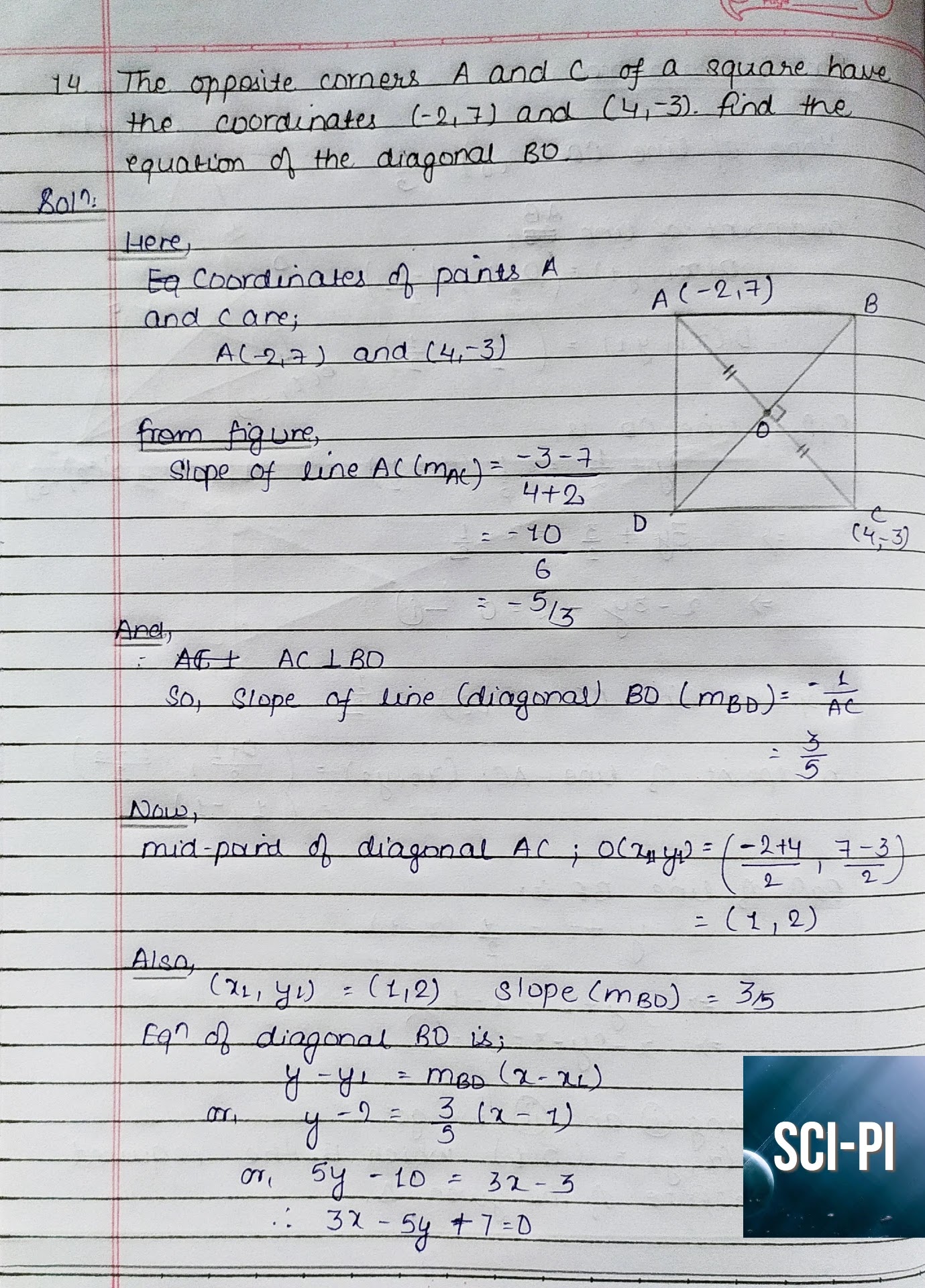In this page, you can find the complete solutions of the first exercise of Analytical Geometry chapter from Basic Mathematics Grade XI book published and distributed by Sukunda Pustak Bhawan.
In the above-mentioned book, analytical geometry is the 9th chapter and has two exercises only. Out of which, this is the solution of the first exercise.
Check: Grade 11 Analytical Geometry Exercise 2 Complete Solutions
Check: Basic Mathematics Grade 11 (Sukunda Publication) Guide:
Disclaimer:
Answers mentioned here are not solved by teachers. These are the solutions written by a student of Grade 11. Answers are all correct. However, the language or process of solving the questions might be informal and in examinations, you might have to add little more language and show more calculations than what has been done here. So, we highly encourage you to view these solutions as guide rather than just copying everything mentioned here. Few questions have been typed while most of them have been updated as pictures.
1. Find the equation of the straight line through the point (2,3) whose
intercept on x-axis is twice that on y-axis.
Solution:
Here,
Passing point (x,y) = (2,3)
To find: equation of straight line under given conditions = ?
Given,
intercept on x-axis (a) is twice that on y-axis (b)
$or, a = 2b$
Put given conditions in double intercept form of equation of straight line, we
get,
$or, \dfrac{x}{a} + \dfrac{y}{b} = 1$
$or, \dfrac{2}{2b} + \dfrac{3}{b} = 1$
$or, \dfrac{1}{b} + \dfrac{3}{b} = 1$
$or, 1 + 3 = b \implies b = 4$
So, $ a= 2*4 = 8$
Now,
$\dfrac{x}{a} + \dfrac{y}{b} = 1$
$or, \dfrac{x}{8} + \dfrac{y}{4} = 1$
$\therefore x + 2y = 8$ is the required equation of the straight line.
2. Find the equation of the straight line which passes through the point
(3,4) and makes intercepts on the axes the sum of whose lengths is 14.
Solution:
Here,
Passing point of the line (x,y) = (3,4)
sum of x-intercept and y-intercept = 14
$or, a + b = 14 \implies b= 14 - a$ --- (i)
Using equation of straight line in double intercept form, we get,
$\dfrac{x}{a} + \dfrac{y}{b} = 1$
$or, \dfrac{3}{a} + \dfrac{4}{14 - a} = 1$
$or, \dfrac{3(14-a) + 4a}{a(14-a)} = 1$
$or, 42 - 3a + 4a = 14a - a^2$
$or, a + 42 = 14a - a^2$
$or, a^2 - 13a + 42 = 0$
$or, (a-6)(a-7) =0$
Either, $(a-6) = 0 \implies a = 6$ So, $b = 8$
Or, $(a-7) = 0 \implies a = 7$ So, $b = 7$
Now,
Equation of straight line when (a,b) = (6,8) is
$\dfrac{x}{a} + \dfrac{y}{b} = 1$
$or, \dfrac{x}{6} + \dfrac{y}{8} = 1$
$or, \dfrac{4x + 3y}{24} = 1$
$\therefore 4x + 3y = 24$
Also,
Equation of straight line when (a,b) = (7,7) is
$\dfrac{x}{a} + \dfrac{y}{b} = 1$
$or, \dfrac{x}{7} + \dfrac{y}{7} = 1$
$\therefore x + y = 7$
3. For what values of k will three points (1,4), (-3,16) and (k,-2)
collinear?
Solution:
Here,
Let $A(x_1, y_1) = (1,4)$
Let $B(x_2,y_2) = (-3,16)$
Let $C(x_3,y_3) = (k,-2)$
For given points to be collinear,
slope of AB = slope of BC must be true
$or, \dfrac{y_2 - y_1}{x_2 - x_1} = \dfrac{y_3 - y_2}{x_3 - x_2}$
$or, \dfrac{16-4}{-3-1} = \dfrac{-2-16}{k+3}$
$or, \dfrac{12}{-4} = \dfrac{-18}{k+3}$
$or, -3 = \dfrac{-18}{k+3}$
$or, 1 = \dfrac{6}{k+3}$
$\therefore k+ 3 = 6 \implies k = 3$
Hence, the required value of k is 3.
Solutions of Questions from 4 to 10 are mentioned in the form of images














11. Prove that the equation of the straight line which passes through the
point $(acos^3 \theta , asin^3 \theta)$ and is perpendicular to the straight
line $x sec \theta + y cosec\theta = a$ is $xcos \theta - ysin \theta = a
cos2 \theta$.
Solution:
Let the required line be AB with slope 'm_1'
Given,
passing point (x,y) = $(acos^3 \theta , asin^3 \theta)$
Here,
line 2 is $x sec \theta + y cosec\theta = a$
Slope of line 2 ($m_2$ ) = $\dfrac{-sec \theta}{cosec \theta} = \dfrac{- sin
\theta}{cos \theta}$
Since line AB and line 2 are perpendicular,
$m_1 * m_2 = -1 \implies m_1 = \dfrac{-1}{m_2}$
$\therefore m_1 = \dfrac{cos \theta}{sin \theta}$
Now,
Put (x,y) and $m_1$ in y = mx +c, we get,
$c = a sin^3 \theta - \dfrac{cos \theta }{sin \theta} * a cos^3 \theta$
$= \dfrac{asin^3 \theta * sin\theta - acos^4 \theta}{sin \theta}$
$= \dfrac{a( sin^4 \theta - cos^4 \theta)}{sin \theta}$
$= \dfrac{a (sin^2 \theta + cos^2 \theta)(sin^2 \theta- cos^2\theta)}{sin
\theta}$
$\therefore c = -\dfrac{a * 1 * cos 2\theta}{sin\theta} \implies c =
\dfrac{-acos2\theta}{sin \theta}$
Again,
$y = mx + c$
$or, y = \dfrac{cos \theta}{sin \theta} x + \dfrac{-cos 2\theta}{sin \theta}$
$or, y = \dfrac{x cos \theta - acos2\theta}{sin \theta}$
$or, y sin \theta = xcos \theta - acos2\theta$
$\therefore xcos \theta - ysin\theta = acos 2\theta$ proved





About the Textbook:
Name: Basic Mathematics Grade XI
Author(s): D.R. Bajracharya | R.M. Shresththa | M.B. Singh | Y.R. Sthapit | B.C. Bajracharya
Publisher: Sukunda Pustak Bhawan (Bhotahity, Kathmandu)
Telephone: 5320379, 5353537
Price: 695 /- (2078 BS)
Buy this book: Basic Mathematics : Grade XI – Sukunda Publication


8 Comments
Nice work.
ReplyDeleteThank you.
DeleteWhere the 12 13 14 15 solutions
ReplyDeleteIt will be updated by today evening.
DeletePlease upload the solutions of ex 9.2 of Analytical geometry plz
ReplyDeleteHere you are Exercise 9.2 Solutions
DeletePlease upload the exercise of properties of traingle
ReplyDeletePlz upload the exercise 11.2 solution of pioneer mathematics
ReplyDeleteYou can let us know your questions in the comments section as well.